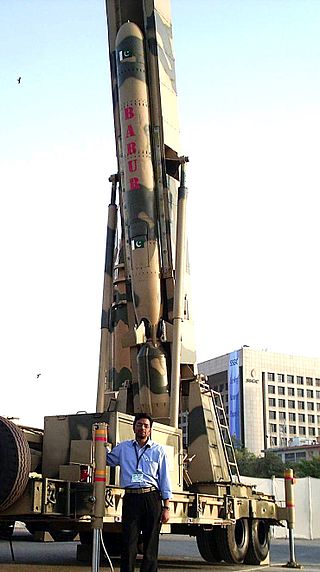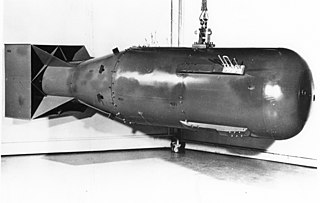
A cruise missile is an unmanned self-propelled guided vehicle that sustains flight through aerodynamic lift for most of its flight path and whose primary mission is to place an ordnance or special payload on a target. Cruise missiles are designed to deliver a large warhead over long distances with high precision. Modern cruise missiles are capable of traveling at high subsonic, supersonic, or hypersonic speeds, are self-navigating, and are able to fly on a non-ballistic, extremely low-altitude trajectory.
The Ghaznavi, is a land-based short range ballistic missile, currently in military service with the strategic command of the Pakistan Army.

The Ghauri–I is a land-based medium-range ballistic missile, in current service with the strategic command of the Pakistan Army.

The Babur is an all-weather, subsonic cruise missile developed and designed by the National Defence Complex (NDC) of Pakistan.

Nuclear weapons delivery is the technology and systems used to place a nuclear weapon at the position of detonation, on or near its target. Several methods have been developed to carry out this task.

The Abdali is a land-based tactical ballistic missile currently in military service with the strategic command of the Pakistan Army.
The Air Weapons Complex (AWC), operated under the National Engineering and Scientific Commission (NESCOM), is a Pakistani research and development entity. Established in 1992 by the Pakistan Air Force, it specialises in advancing airborne applications of explosive engineering.

The National Engineering & Scientific Commission (NESCOM) is a Pakistani government-funded defence contractor that develops, designs and sells defense hardware, including missile and weapon systems. It was funded and formed by the Government of Pakistan to develop its domestic production of weapon system.

A nuclear triad is a three-pronged military force structure of land-based intercontinental ballistic missiles (ICBMs), submarine-launched ballistic missiles (SLBMs), and strategic bombers with nuclear bombs and missiles. Countries build nuclear triads to eliminate an enemy's ability to destroy a nation's nuclear forces in a first-strike attack, which preserves their own ability to launch a second strike and therefore increases their nuclear deterrence.
The Shaheen-II, is a land-based medium-range ballistic missile currently in deployed in military service with the strategic command of the Pakistan Army.
The H-4 SOW is a precision-guided glide bomb manufactured by NESCOM and deployed by the Pakistan Air Force, capable of striking targets at stand-off range. It has a terminal guidance system based on an infrared homing seeker, which identifies the target during the final stage of flight. Designed to hit targets out to 120 km, the bomb may have the capability to evade radar.

The Shaheen-I, is a land-based short-range ballistic missile designed and developed by the National Defence Complex and National Engineering & Science Commission.
The Hatf Program ) was a classified program by the Ministry of Defence (MoD) of Pakistan for the comprehensive research and development of guided missiles. Initiatives began in 1986-87 and received support from Prime Minister Benazir Bhutto in direct response to India's equivalent program in 1989.
The Nasr, is a solid fueled tactical ballistic missile system developed by the National Development Complex (NDC) of Pakistan, currently in service with the Pakistan Army.

Ra'ad is an Iranian designed and built subsonic anti-ship cruise missile. The missile is a reverse engineered and upgraded variant of China's Silkworm anti-ship missile. The missile was developed by the state-run Iran Aviation Industries Organization (IAIO). Iran reportedly began full production of the Ra’ad in January 2004 and went into service in 2007. The missile is equipped for ground and ship-launched platforms.

An air-launched cruise missile (ALCM) is a cruise missile that is launched from a military aircraft. Current versions are typically standoff weapons which are used to attack predetermined land and naval targets with conventional, nuclear or thermonuclear payloads.
The Ra'ad-II is a standoff and an air-launched cruise missile (ALCM) derived from the Hatf-VIII Ra'ad. It was first publicly unveiled on the Pakistan Day Parade on 23 March 2017,








